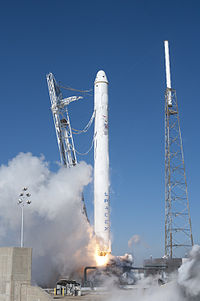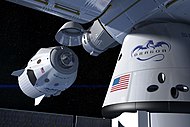Falcon 9 v1.0
| Falcon 9 v1.0 | |
 | |
| Fakta | |
|---|---|
| Tillverkare | SpaceX |
| Land | USA |
| Mått | |
| Höjd | 54,9 m |
| Diameter | 3,66 m |
| Massa | 333 400 kg |
| Antal steg | 2 st |
| Kapacitet | |
| Nyttolast till LEO | 10 450 kg |
| Nyttolast till GTO | 4 540 kg |
| Familj | |
| Familj | Falcon 9 |
| Efterföljare | Falcon 9 v1.1 |
| Historik | |
| Status | Avvecklad |
| Uppskjutningsplatser | SLC-4E Vandenberg LC-40 Cape Canaveral |
| Uppskjutningar | 5 st |
| Lyckade | 4 st |
| Delvis misslyckade | 1 st |
| Jungfrufärd | 4 juni 2010 |
| Sista färd | 1 mars 2013 |
| Nyttolaster | Dragon |
| Första steget - | |
| Motorer | 9x Merlin 1C |
| Kraft | 4 940 kN |
| Bränntid | 170 sek |
| Bränsle | RP-1/Flytande syre |
| Andra steget - | |
| Motorer | 1x Merlin 1C Vacuum |
| Kraft | 445 kN |
| Bränntid | 345 sek |
| Bränsle | RP-1/Flytande syre |
Falcon 9 v1.0 var en amerikansk bärraket designad av SpaceX, den första versionen av Falcon 9 raketen. Första uppskjutningen gjordes från LC-40 vid Cape Canaveral Air Force Station, den 4 juni 2010.
Versionen användes 5 gånger mellan juni 2010 och mars 2013. Raketen hade en startvikt på 333 400 kg och vid uppskjutning från Cape Canaveral, kunde den placera 10 450 kg i omloppsbana runt jorden.
Uppskjutningar
Lista över SpaceX raketuppskjutningar
Se även
- Falcon 1
- Falcon 5
- Falcon 9
- Falcon Heavy
Källor och referenser
| ||||||||||||||||||||||||||||||||||||||||||||||||||||||||
Media som används på denna webbplats
SpaceX’s Falcon 9 rocket and Dragon spacecraft lift off from Launch Complex-40 at Cape Canaveral Air Force Station, Fla., at 10:43 a.m. EST. In orbit, the Dragon capsule will go through several maneuvers before it re-enters the atmosphere and splashes down in the Pacific Ocean about 500 miles west of the coast of Mexico. This is first demonstration flight for NASA's Commercial Orbital Transportation Services (COTS) program, which will provide cargo flights to the International Space Station in the future.
Författare/Upphovsman: SpaceX, Licens: CC0
This artist's concept shows a SpaceX Crew Dragon docking with the International Space Station as it will during a mission for NASA's Commercial Crew Program. NASA is partnering with Boeing and SpaceX to build a new generation of human-rated spacecraft capable of taking astronauts to the station and expanding research opportunities in orbit.
Författare/Upphovsman: Space Exploration Technologies Corp., Licens: CC0
The 2018 version of the Big Falcon Rocket at stage separation: Starship (foreground) and Super Heavy (background)






